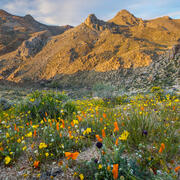Rangeland Management
Rangeland Management
Filter Total Items: 25
USGS Science Syntheses for Public Lands Management
Scientific information is fundamental to understanding how proposed actions on public lands may impact the environment. Development of new science is occurring at rates that can make it challenging for biologists, resource managers, decision makers, private landowners, and other stakeholders to ensure they are using up-to-date, high-quality science information to inform their decisions. Further...
Skill-building workshops for researchers on the coproduction of actionable science
Public lands management requires the use of science, but agency staff rarely have time to stay current with all the science on management-relevant topics, especially as articles are published at an ever-increasing rate. In this new series of learning modules, we aim to provide scientists with essential tools, skills, and strategies for coproducing actionable science products with and for federal...
SBSC: Providing Unbiased Actionable Science & Information to Support Natural Resource Management Needs of the U.S. & Department of the Interior Priorities
The U.S. Geological Survey Southwest Biological Science Center (SBSC) is uniquely positioned in the Colorado River Basin to provide sound information, specialized expertise, and innovative tools to support the management and sustained use of natural resources on public and Tribal lands in the Southwest U.S.
Supporting energy and mineral development through successful reclamation
Federal lands of the US contain important reserves of oil, gas and other resources important for Unleashing American Energy (SO 3418). After development of these resources is complete, successfully reclaiming disturbed lands is a necessary step towards restoring wildlife habitat, forage production, and maintaining natural resources for future use. To improve reclamation outcomes on these lands and...
RAMPS: Restoration Assessment & Monitoring Program for the Southwest
The Restoration Assessment and Monitoring Program for the Southwest (RAMPS) seeks to assist U.S. Department of the Interior (DOI) and other land management agencies in developing successful techniques for improving land condition in dryland ecosystems of the southwestern United States. Invasion by non-native species, wildfire, drought, and other disturbances are growing rapidly in extent and...
Plant responses to drought in the southwestern United States
Land managers face challenges in the future as heat-related aridification alters the abundance, distribution, and interactions of plant species. These challenges will be daunting in the southwestern US, which is experiencing increased temperatures and prolonged droughts, resulting in reduced soil moisture in an already water-limited environment.
SBSC Tribal Partnerships
The Southwest Biological Science Center (SBSC) conducts and provides scientific information as part of our mission and Federal Trust Responsibility to strengthen relationships and build partnerships with sovereign tribal nations. Here, we highlight a few examples of projects with tribal partners.
Colorado Plateau Extreme Drought in Grassland Experiment (EDGE)
In drylands, short-term extreme droughts can have profound ecosystem effects, depending on the timing (seasonality) of drought and the sensitivities of the dominant plants and plant functional types. Past work suggests that cool season drought may disproportionately impact regionally important grass and shrub species. In this study, we are examining the impacts of extreme seasonal drought on...
Chronic Drought Impacts on Colorado Plateau Ecosystems (Rain-Out Experiment)
In drylands, chronic reductions in water availability (press-drought) through reduced precipitation and increased temperatures may have profound ecosystem effects, depending on the sensitivities of the dominant plants and plant functional types. In this study, we are examining the impacts of moderate, but long-term chronic drought using a network of 40 drought shelters on the Colorado Plateau...
Genetics for Western Restoration and Conservation (GWRC)
Research using genetic principles, methods, and data provides critical information for restoration and conservation science. Genetic research may rely only upon genomic sequencing techniques, which generate abundant, genome-wide DNA sequences that can provide a glimpse into a species’ evolutionary history and adaptations. Genetic research may also look at an organism’s physical traits to...
Drought Adaptation Strategies for Arid Grasslands
Helping National Parks in the 4-Corners region manage grasslands in a changing world.
Biological Soil Crust ("Biocrust") Science
Biological soil crusts (biocrusts) are commonly found on the soil surface in arid and semi-arid ecosystems (collectively called drylands). Biocrusts can consist of mosses, cyanobacteria, lichens, algae, and microfungi, and they strongly interact with the soil. These organisms or consortium of disparate organisms, depending on the specific biocrust, are important to the functioning of ecosystems...













